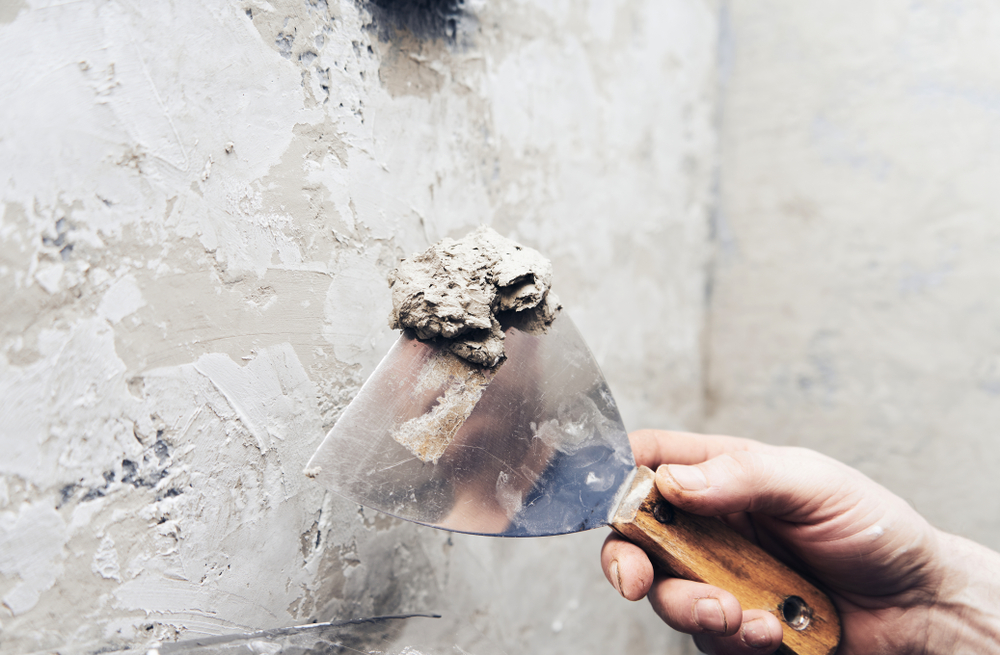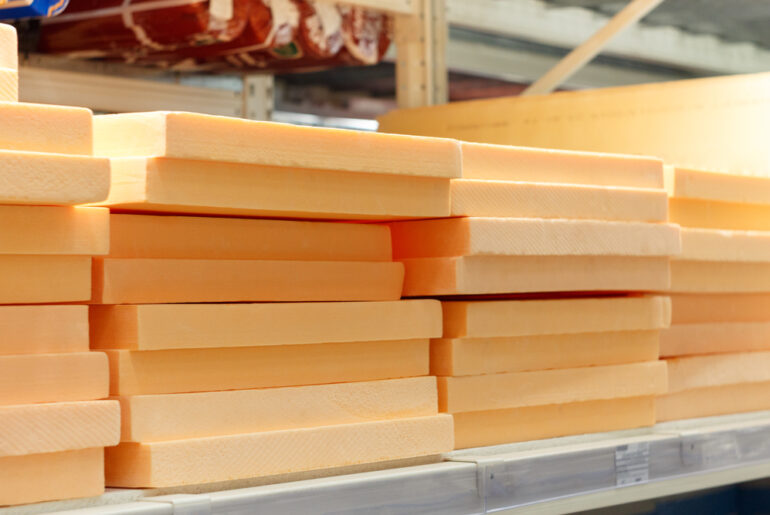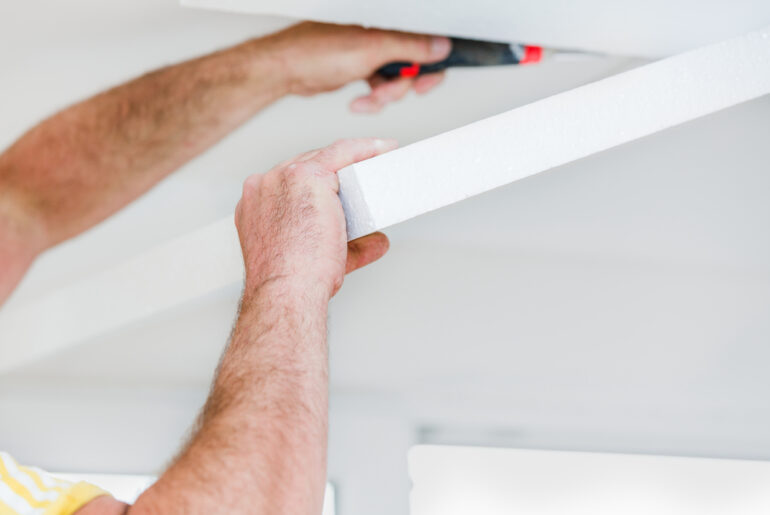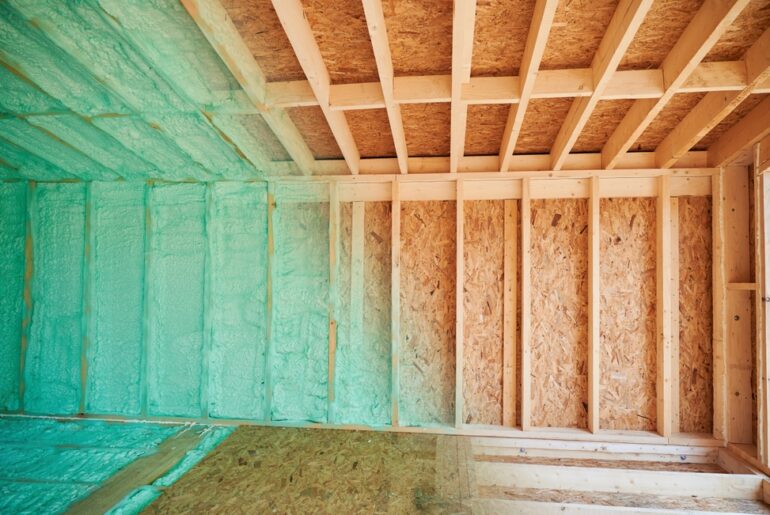You not only can, but should install stucco over rigid foam insulation. Stucco is a masonry slurry (very thin cement) applied to metal lathe, which is a type of net. The stucco is squeezed through the holes in the lathe and hardens around it, forming a solid surface.
In a standard stucco installation, before the lathe is mounted to the wooden framing, the framing is wrapped in rigid foam insulation panels. Installing rigid foam panels under the lathe keeps the lathe flat and uniform, while adding R value.
Here we will discuss how stucco works over rigid foam insulation and the process the pros use to install it.
Why Is Stucco Installed Over Rigid Foam Insulation?
Stucco, much like plaster, requires a mostly flat surface with enough texture to grab the material and hold it in place until it dries. In the case of stucco, the flat surface with texture is metal lathe. Metal lathe can be sold in rolls or sheets, depending on the gauge of the metal.
Generally, if the entire home will be stuccoed (as opposed to just the foundation), a house wrap is usually installed first, followed by rigid foam insulation, itself followed by the metal lathe and stucco.
You’ll want to research your stucco project thoroughly, as some older installation methods have been shown to cause water damage. Follow the directions carefully, but generally the process described above is common among manufacturers.
How Is Stucco Installed Over Rigid Foam Insulation?
The stucco process can take several forms, but the most common involves a scratch coat, a brown coat, and a finish coat. The scratch coat is rough in texture and high on bonding. The scratch coat forms the foundation for the coats that follow.
The scratch coat is designed to be squeezed through the lathe and connect to itself around the metal. The scratch coat, as with the subsequent coats, usually include an additive that keeps the stucco somewhat flexible, which reduces cracks.
The brown coat is usually a finer texture than a scratch coat and is specifically designed to bond to both a scratch coat and a finish coat. Most stucco technicians use different sized trowels to apply the brown coat, depending on the desired effect.
The last step is the application of the final coat, also known as the top coat. The top coat is usually colored to reduce the need for paint. The top coat will often define the style of the finish, like dash, Santa Barbara, and sand.
Which Rigid Foam Do I Use Under Stucco?
The vast majority of stucco is installed over polystyrene rigid foam panels because they maintain their shape and repel moisture. Polystyrene rigid panels are available in many sizes, thicknesses, and densities.
The best strategy is to follow the directions that come with your stucco. All manufacturers provide detailed installation instructions and underlayment requirements. Some brands can be installed in only two coats, while others are designed primarily to provide texture or color.
Most brands can be applied using the methods outlined above, but some may require additives or specific underlayments. Most designs will also require weep holes (small rubber tubes) embedded into the stucco for additional drainage.
Is It Hard to Install Rigid Foam Insulation Under Stucco?
Most installers will agree that installing the rigid foam insulation is the easy part of a stucco project. Usually, the rigid foam panels are glued or stapled to the sheathing, as is the lathe. The rigid foam insulation does not add significant weight to the structure, but the stucco will.
For this reason, the lathe is often secured directly to the framing, using fasteners long enough to penetrate both the rigid panels and sheathing. Galvanized fasteners are required for this task, as standard steel nails or screws would rust.
Some installers prefer button cap nails because they provide better holding power. Button cap nails (and screws) have a large plastic or metal washer that functions as a large head. Button cap nails can often be identified by their color, which is usually green or orange for easy visibility.
How Thick Should Rigid Foam Insulation Be Under Stucco?
The thickness, and thus the R value, will be determined by the construction of the panel. Generally, rigid foam panels 2” thick or thicker are considered adequate for stucco. However, some methods require heavier materials so read your directions carefully.
As a rule, you want to avoid using rigid foam panels thicker than 2” in a single layer. Doing so will make the adhesive work harder or force you to use very long nails or screws. Most stucco applications work fine with a 2” foam backing, but check the requirements for your stucco.
Can I Apply Stucco Directly to Rigid Foam Insulation?
Generally, you cannot install stucco directly to rigid foam panels because they are not designed to support any weight other than their own. In addition, rigid foam panels are too smooth to grab the stucco material, allowing it to slide off the panel.
To be clear, some manufacturers offer specially designed rigid foam insulation panels that have the lathe built in. These types of foam panels are designed to be time savers, but there may be limitations to their use depending on the application.
Can I Install Stucco Without Rigid Foam Insulation?
You can install stucco without rigid foam insulation, but it’s a bad idea. The other option is to install pressure treated plywood instead, which weighs much more than rigid foam. Pressure treated plywood might also interact with the metal lathe and cause corrosion.
For this reason, the plywood is usually allowed a year or so to dry out from the chemical process and then wrapped in roofing felt or housewrap. Plywood also offers little if any R value, so rigid panels are more appropriate for stucco.
Can Rigid Foam Insulation Touch the Ground?
One of the great features of rigid foam insulation panels is that the material is rated for ground contact. Many new homes are insulated from the outside using rigid foam panels glued to the foundation and covered with backfill.
Rigid foam insulation used in this fashion also provides a cushion against the hydrostatic pressure created when the ground freezes. The panels will require the addition of hydrophobic tape over any seams to prevent water infiltration between layers.





